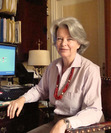Claude Forthomme's Blog, page 28
July 7, 2014
The Author-Reader Amazon Revolution:Mirage or Reality?
Indie writers, and that means "self-published authors", are up in arms over the Amazon-Hachette spat, all rushing in the defense of Amazon. For a perfect example of the sort of blog post siding for Amazon, see here (or link to it here):

Yes, the Big Publishers, once upon a time six big publishing houses and now down to five (but for how long?), "controlled the book industry." As explained in that blog, "They decided which stories you were allowed to read. They decided which authors were allowed to publish. They charged high prices while withholding less expensive formats. They paid authors as little as possible, usually between 2% and 12.5% of the list price of a book".
Amazon, on the other hand, "trusts you to decide what to read, and they strive to keep the price you pay low. They allow all writers to publish on their platform, and they pay authors between 35% and 70% of the list price of the book."
Then, at the end of the post, there's a petition to sign, open to readers and writers alike, see here.
PLEASE NOTE THE NUMBER OF PEOPLE who have signed that petition.
Notice something strange? So far, very few people have signed - at the time of writing (July 6), only 4, 804.
Surprised? I must admit I am - I thought more self-published authors would have joined in by now. If you drift down to the comments, you get a sense of who signed - mostly self-published authors.
You first come across David Gaughan's strong statement (trust him, he's a fighter!):"Amazon has done more than any other company to create a level playing field where hundreds (and probably thousands) of independent authors like me can make a living from book sales for the very first time. As a reader, I recognize that Amazon has done more than any other company to create the digital market, and to lower prices for readers. Publishers are fighting to increase those prices and to prevent Amazon from discounting. As a writer and a reader I think this would be an awful, regressive move - probably designed to protect the status quo and the millionaire status of a small group of bestselling authors. Don't believe the anti-Amazon hype!"
David Gaughan is certainly one of self-publishing's major success stories - as are the next commentators down the line, Hugh Howey, Theresa Ragan, John A. A. Logan, all leaving testimony to their success thanks to Amazon.
And to think that this is a website - the blog title says it all: ebooksuccess4free - with over 2,000 followers, to be exact: 2,612 at the time of writing! I'm just saying that to point out the extent of the Indie "revolution", the number of people who are taken in by this kind of language and are no doubt already self-published or thinking of it.
If one goes by the number of signatories to that petition, then it becomes obvious that at least 4,500 self-pubbed authors feel strongly loyal to Amazon. Not a big number but certainly a vocal core group!
Because, quite clearly, these are all people who have bought into the Indie ideology, people who overlook or want to ignore the simple economic fact that "New York Publishing" that once "controlled" the book industry was in that "control" position merely because, following American Capitalism tenets, the Big Publishers in New York were better able to produce a good product (read: best selling book) than all the others - than small presses, and of course, vanity presses (that's where self-publishing authors used to be found).
It's not a matter of "control" but a matter of excellence.
And, contrary to what is written in that blog, Big Publishers never decided which stories readers were "allowed to read" or which authors were "allowed to publish". Allowed by whom? Book publishing is not a terroristic industry!
Book publishing is subject to the laws of the market like any other industry. What people want to read sells, what they don't want to read, doesn't sell.
It's not the Big Publishers who "decide" but the readers.
Self-publishing is the way to go if you can't wait (at least) three years before seeing your book in print - and three years is probably on the optimistic side.
Consider: you need to send queries to literary agent and hope that you will land one. Recent data shows that agents receive on average over 3,000 queries per year and take on...2 new clients a year! Do the math, or rather, don't do it, it will get you depressed. Once you've signed a contract with an agent, it doesn't mean your book will be grabbed by a publisher, that could take another six months or more (if it works - if not, back to square one with a new book). And once a publisher has taken you on, it's another 18 months at least before your book hits a shelf in a bookstore.
Self-publishing is incredibly fast, on average three weeks rather than three years.
Consider: from the moment your draft has been finalized and fully edited, you might spend another week or two on the book cover (either do it yourself or get a book designer to do it for you, the safer way to get a professional looking cover) and three or four days to upload your book on the various e-platforms, mainly KDP, Smashwords for onward distribution to all the others and Google Books. None of it is technically challenging, all you need is a regular word document, a good quality jpeg image for your cover, and you're done. Super easy.
Self-publishing is for control freaks and Amazon lovers (that's where it works best for all authors, including new ones). It makes sense for anyone with the daring spirit of an entrepreneur, but - and it's a very big "but"! - once your book is up there, on Amazon's virtual shelves, the real work starts.
 Flower Child ~ Published Book Cover (Photo credit: LadyDragonflyCC - >;<)
Flower Child ~ Published Book Cover (Photo credit: LadyDragonflyCC - >;<)
Marketing.
You need to reach out to your readers, your market. And let's face it, for an author who loves to write and let his/her imagination fly, marketing is devastating. It's not in his/her genes. And even if it happens to be in those damn genes, it's a time and energy suck.
True, marketing is not something only self-published authors have to do. Even traditionally published authors have to engage in a lot of book promotion, go on book tours, sign copies etc but a whole lot more is needed if you are self-published... unless you're one of those savvy professional authors who's been traditionally published before and you have a fan base you can count on to get your book started on all those Amazon best-seller lists.
Don't kid yourself, Amazon's best seller lists remain the best way to sell books in the digital world.
And, depending on the kind of book you've written, there are many kinds of lists you can be on. Metadata, hello!
Make sure you've got your metadata - your book description and keywords - right for your book so that it goes into the "right" slot where readers can find it. Because Amazon has been incredibly kind to authors (and publishers!): they've multiplied the lists to fit an eye-popping range of genres, from recondite stuff like "aging" to "space opera" - the idea of course is to help readers find the most popular (read best-selling) books in their particular area of interest.
If you're a midlist author and already have fans looking for your books, they'll be happy to read one of the titles you've pulled out of your back list - books they may have missed or that they'll want to buy in digital version to read again because it was one of their favorites, they've read it many years ago and have now half-forgotten it. And if the price is very low, why not, stick in the Kindle and read it on the plane or while waiting at the dentist's.
And the more you sell on Amazon, the more you sell. It's like a stone gathering moss. The famous section "other customers also bought" gets filled with books in similar genres and people will click on all those other titles...and get to yours! Neat!
Sales propel more sales.
If you have any doubts about the importance of cracking the Amazon sales rankings, Smashwords most recent survey leaves no doubts about it whatsoever, see here:
2014 Smashwords Survey - How to Sell More Ebooks from Smashwords, Inc.
The trouble is to get that damn ball rolling.
For a long time - roughly from 2009 to 2013- self-publishing was a manna from Heaven for traditionally-published authors with a recognizable name in their genre; at least for all those able to get back the rights to their back list.
But now, most of them have gone through their back list and have no new title to offer...unless they quickly write a new book. So, it should come as no surprise that sales in the Kindle store (and on other e-platforms) have hit a plateau. Midlist authors have run their course.
The digital gold rush is over.
There are other reasons too:
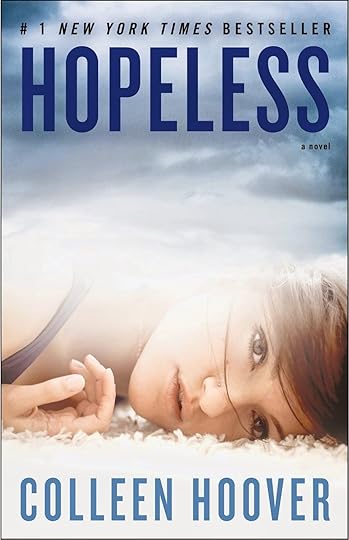 Existing ereaders are filled to the brim with low-priced and free books. The market for ereaders is still expanding but at a lower rate. The fast pace of growth of early days is gone - this is normal for a gadget reaching maturity.Add to that the huge number of titles available in the Kindle store and elsewhere. Because it was so easy to self-publish, there's been a tsunami of self-published authors since the Kindle was launched six years ago. Amazon won't reveal the number of titles in the Kindle Store, but it's likely to be around 4 million, and probably half of that is self-published. Anyone with numbers is welcome to comment below, nothing would be more desirable than having some solid data.In spite of this vast number of available titles, few authors manage to sell over 100,000 copies of their books. In Amazon's year end report for 2013, you find that, yes, 25% of their book sales came from self-published authors but also only "150 Kindle Direct Publishing authors each sold more than 100,000 copies of their books in 2013". Top sellers, we are informed, included "Hopeless" by Colleen Hoover and "Wait for Me" by Elizabeth Naughton. One hundred and fifty authors! Out of how many hundreds of thousands of self-published authors (perhaps even a million or two)?
Existing ereaders are filled to the brim with low-priced and free books. The market for ereaders is still expanding but at a lower rate. The fast pace of growth of early days is gone - this is normal for a gadget reaching maturity.Add to that the huge number of titles available in the Kindle store and elsewhere. Because it was so easy to self-publish, there's been a tsunami of self-published authors since the Kindle was launched six years ago. Amazon won't reveal the number of titles in the Kindle Store, but it's likely to be around 4 million, and probably half of that is self-published. Anyone with numbers is welcome to comment below, nothing would be more desirable than having some solid data.In spite of this vast number of available titles, few authors manage to sell over 100,000 copies of their books. In Amazon's year end report for 2013, you find that, yes, 25% of their book sales came from self-published authors but also only "150 Kindle Direct Publishing authors each sold more than 100,000 copies of their books in 2013". Top sellers, we are informed, included "Hopeless" by Colleen Hoover and "Wait for Me" by Elizabeth Naughton. One hundred and fifty authors! Out of how many hundreds of thousands of self-published authors (perhaps even a million or two)?
 "Hopeless" was traditionally published, by Simon & Shuster UK in July 2013, and in just one year got 7,322 reviews. Elizabeth Naughton, the author of "Wait for Me", has a more interesting experience to offer. As she told Galley Cat (see here), she launched her book by giving away 500,000 copies between the end of 2012 and the middle of January 2013, and, as she proudly noted, "now that book is the #2 overall bestseller at Amazon and has been ranked in the top 100 for more than two weeks.” She is indeed a very savvy and active marketer; to understand this, take a look at her blog here. "Wait for Me" gathered 2,661 reviews since it was published in 2011. Now, selling at a 66 percent discount, it maintains a remarkably high level in Amazon's best seller ranks, though no longer #2 but around #5000, pretty good considering it's not "new". For her, an author of dark, romantic, paranormal noir novels, one of the best selling genres on Amazon, the gold rush is surely not over.
"Hopeless" was traditionally published, by Simon & Shuster UK in July 2013, and in just one year got 7,322 reviews. Elizabeth Naughton, the author of "Wait for Me", has a more interesting experience to offer. As she told Galley Cat (see here), she launched her book by giving away 500,000 copies between the end of 2012 and the middle of January 2013, and, as she proudly noted, "now that book is the #2 overall bestseller at Amazon and has been ranked in the top 100 for more than two weeks.” She is indeed a very savvy and active marketer; to understand this, take a look at her blog here. "Wait for Me" gathered 2,661 reviews since it was published in 2011. Now, selling at a 66 percent discount, it maintains a remarkably high level in Amazon's best seller ranks, though no longer #2 but around #5000, pretty good considering it's not "new". For her, an author of dark, romantic, paranormal noir novels, one of the best selling genres on Amazon, the gold rush is surely not over.
In an ocean of books, how can your poor little one float to the top? Who says it's good and worth reading? Nobody in the mainstream press (the New York Times, the UK Guardian, the Washington Post, the Wall Street Journal etc etc): articles there are reserved for traditionally published authors. Self-published authors cannot expect to get critique from literary gurus - all they get are Amazon "customer reviews" - better than nothing but rarely professional, though Amazon has tried to create a "professional" group of critics through its Vine Program that selects the most popular reviewers.
Self-published authors can't even expect to get attention from presenters on any of the major TV or radio shows. At best, they get attention from literary bloggers who have reasonable traffic on their blogs, though, as a recent Gallup survey indicated, nobody buys following advice on social networks (only 5% do).
What recently happened to Edan Lepucki's debut novel "California" published by one of the Hachette Group imprints, could never have happened to a self-published author. That kind of fairy tale is reserved to traditionally published authors. Indies, not unsurprisingly, are very angry at Stephen Colbert who got the ball rolling on his TV show by brandishing the "California" book and urging viewers to buy it, as a way to counter Amazon.
For more about this, here is the New York Times article (click here), calling Edan Lepucki a "winner in the Amazon war" when she got an unexpected "boost from Colbert". No less than the New York Times paid attention to this minor event!
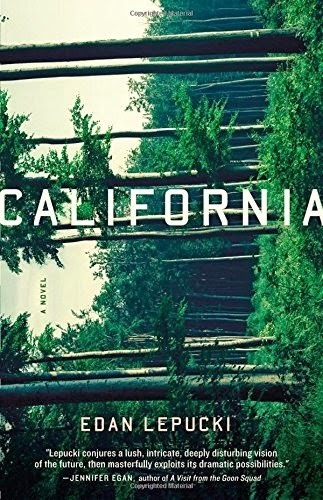
Yes, major writers, TV personalities, mainstream journalists and celebrities of all sorts are siding with Hachette and the traditional publishing industry against Amazon, and hence, self-published authors. Just to quote one major author, a Pulitzer Prize winner: "In her arresting debut novel, Edan Lepucki conjures a lush, intricate, deeply disturbing vision of the future, then masterfully exploits its dramatic possibilities." ---Jennifer Egan, author of A Visit from the Goon Squad.
And, needless to add, self-published authors do not have access to the more prestigious literary prizes of the calibre of the Pulitzer or Man Booker. That's an out-of-bound area for all indies. For how long? Who knows, but one thing is certain, it's not a situation that is about to change anytime soon.
In other words, anyone considering self-publishing should realize that the road ahead is very short. No important prize will come your way, no major literary critic will ever pay attention. Even someone like Hugh Howey who was an outstanding success with his famous WOOL is still waiting for recognition from the "publishing establishment" - even though he got a deal with Simon and Shuster as well as a film contract.
When Amanda Hocking, historically the first self-published author to achieve success, accepted the contract offered by St Martin's Press, a prestigious traditional publisher, she knew what she was doing. She explained it quite clearly, saying something like "I want to become a household word across America" (that's what I remember reading at the time).
Indeed, no self-publisher can ever hope to achieve that. For many reasons, that I plan to explore in various blog posts over the next few weeks. My goal is very simple: based on my own experience as an author and observations as an economist, I want to cut through all the hype surrounding self-publishing and get to the truth - nothing less can help my fellow writers, and in particular any aspiring writer wondering whether to go the traditional road or attempt self-publishing.
And the truth is that if you are an ambitious author looking to be read by as many people as possible (in my view, a legitimate goal), you will never become, as Amanda Hocking pointed out, a "household word" unless you are traditionally published.
True, a number of self-published authors manage to sell over 100,000 copies per year and make a decent living out of it. Good for them! But they are very, very few, an absolute minority - something akin to the percentages that get picked up by literary agents; we are talking of 0,002 percent and less.
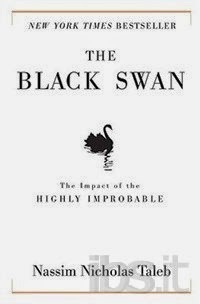 We are talking about black swans - the kind of high improbability that Nassim Taleb wrote about in his 2007 best seller.
We are talking about black swans - the kind of high improbability that Nassim Taleb wrote about in his 2007 best seller.
Yet we read in all the blogs of self-published authors that have made a success of their publishing venture, from J.A. Konrath's Publishing Guide for Newbies to sites like the one mentioned above, that self-publishing is the way to go. It pays for itself, it's rational, it puts you in charge of your books and your earnings. And, cherry on the cake, the stigma that used to be attached to vanity presses and self-publishing, is gone.
The digital revolution has miraculously done away with that stigma!
Do you believe in miracles? If you're a writer seeking to publish your books, don't believe in miracles, you could be deeply disappointed...
Look for more about the stigma attached to self-publishing in a future post about my "lessons learned" in self-publishing, and in the meantime, I've collected a few articles for you below.
Related articles:
 Amazon is not your best friend: Why self-published authors should side with Hachette
Amazon is not your best friend: Why self-published authors should side with Hachette
 Authors Enter the Fray in Amazon Vs Hachette Dispute
Authors Enter the Fray in Amazon Vs Hachette Dispute
 How Amazon is Trying to Rescue Literary Fiction
How Amazon is Trying to Rescue Literary Fiction
 Literary Agents Are Watching Blogs & Amazon Bestseller Lists
Literary Agents Are Watching Blogs & Amazon Bestseller Lists
 Hachazon War: the Battle of Petition Hill
Hachazon War: the Battle of Petition Hill
 Colbert on Amazon-Hachette, Konrath on ColbertNow, my question to you. It concerns the "Hachazon War".
Colbert on Amazon-Hachette, Konrath on ColbertNow, my question to you. It concerns the "Hachazon War".
Considering that Amazon is trying to change in its favor the terms with a Big Publisher (Hachette), down to 50%, and considering that there is nothing to encourage Amazon to continue to pay 70% to self-published authors, are you going to sign that petition?
What are your reasons for signing (or not signing)? Please share.
My opinion? I have a confession to make: the Hachazon War could be the handwriting on the wall. If Amazon is standing up to Hachette, why should it give a better deal to self-published authors? It looks like the time has come, in Amazon's view, to tighten the screws and start making money - pulling 50% in rather than the 30% it has accepted so far. And if they do decide to go down that road, what can self-published authors do to stop them? Sign another petition?










Yes, the Big Publishers, once upon a time six big publishing houses and now down to five (but for how long?), "controlled the book industry." As explained in that blog, "They decided which stories you were allowed to read. They decided which authors were allowed to publish. They charged high prices while withholding less expensive formats. They paid authors as little as possible, usually between 2% and 12.5% of the list price of a book".
Amazon, on the other hand, "trusts you to decide what to read, and they strive to keep the price you pay low. They allow all writers to publish on their platform, and they pay authors between 35% and 70% of the list price of the book."
Then, at the end of the post, there's a petition to sign, open to readers and writers alike, see here.
PLEASE NOTE THE NUMBER OF PEOPLE who have signed that petition.
Notice something strange? So far, very few people have signed - at the time of writing (July 6), only 4, 804.
Surprised? I must admit I am - I thought more self-published authors would have joined in by now. If you drift down to the comments, you get a sense of who signed - mostly self-published authors.
You first come across David Gaughan's strong statement (trust him, he's a fighter!):"Amazon has done more than any other company to create a level playing field where hundreds (and probably thousands) of independent authors like me can make a living from book sales for the very first time. As a reader, I recognize that Amazon has done more than any other company to create the digital market, and to lower prices for readers. Publishers are fighting to increase those prices and to prevent Amazon from discounting. As a writer and a reader I think this would be an awful, regressive move - probably designed to protect the status quo and the millionaire status of a small group of bestselling authors. Don't believe the anti-Amazon hype!"
David Gaughan is certainly one of self-publishing's major success stories - as are the next commentators down the line, Hugh Howey, Theresa Ragan, John A. A. Logan, all leaving testimony to their success thanks to Amazon.
And to think that this is a website - the blog title says it all: ebooksuccess4free - with over 2,000 followers, to be exact: 2,612 at the time of writing! I'm just saying that to point out the extent of the Indie "revolution", the number of people who are taken in by this kind of language and are no doubt already self-published or thinking of it.
If one goes by the number of signatories to that petition, then it becomes obvious that at least 4,500 self-pubbed authors feel strongly loyal to Amazon. Not a big number but certainly a vocal core group!
Because, quite clearly, these are all people who have bought into the Indie ideology, people who overlook or want to ignore the simple economic fact that "New York Publishing" that once "controlled" the book industry was in that "control" position merely because, following American Capitalism tenets, the Big Publishers in New York were better able to produce a good product (read: best selling book) than all the others - than small presses, and of course, vanity presses (that's where self-publishing authors used to be found).
It's not a matter of "control" but a matter of excellence.
And, contrary to what is written in that blog, Big Publishers never decided which stories readers were "allowed to read" or which authors were "allowed to publish". Allowed by whom? Book publishing is not a terroristic industry!
Book publishing is subject to the laws of the market like any other industry. What people want to read sells, what they don't want to read, doesn't sell.
It's not the Big Publishers who "decide" but the readers.
Self-publishing is the way to go if you can't wait (at least) three years before seeing your book in print - and three years is probably on the optimistic side.
Consider: you need to send queries to literary agent and hope that you will land one. Recent data shows that agents receive on average over 3,000 queries per year and take on...2 new clients a year! Do the math, or rather, don't do it, it will get you depressed. Once you've signed a contract with an agent, it doesn't mean your book will be grabbed by a publisher, that could take another six months or more (if it works - if not, back to square one with a new book). And once a publisher has taken you on, it's another 18 months at least before your book hits a shelf in a bookstore.
Self-publishing is incredibly fast, on average three weeks rather than three years.
Consider: from the moment your draft has been finalized and fully edited, you might spend another week or two on the book cover (either do it yourself or get a book designer to do it for you, the safer way to get a professional looking cover) and three or four days to upload your book on the various e-platforms, mainly KDP, Smashwords for onward distribution to all the others and Google Books. None of it is technically challenging, all you need is a regular word document, a good quality jpeg image for your cover, and you're done. Super easy.
Self-publishing is for control freaks and Amazon lovers (that's where it works best for all authors, including new ones). It makes sense for anyone with the daring spirit of an entrepreneur, but - and it's a very big "but"! - once your book is up there, on Amazon's virtual shelves, the real work starts.
 Flower Child ~ Published Book Cover (Photo credit: LadyDragonflyCC - >;<)
Flower Child ~ Published Book Cover (Photo credit: LadyDragonflyCC - >;<)Marketing.
You need to reach out to your readers, your market. And let's face it, for an author who loves to write and let his/her imagination fly, marketing is devastating. It's not in his/her genes. And even if it happens to be in those damn genes, it's a time and energy suck.
True, marketing is not something only self-published authors have to do. Even traditionally published authors have to engage in a lot of book promotion, go on book tours, sign copies etc but a whole lot more is needed if you are self-published... unless you're one of those savvy professional authors who's been traditionally published before and you have a fan base you can count on to get your book started on all those Amazon best-seller lists.
Don't kid yourself, Amazon's best seller lists remain the best way to sell books in the digital world.
And, depending on the kind of book you've written, there are many kinds of lists you can be on. Metadata, hello!
Make sure you've got your metadata - your book description and keywords - right for your book so that it goes into the "right" slot where readers can find it. Because Amazon has been incredibly kind to authors (and publishers!): they've multiplied the lists to fit an eye-popping range of genres, from recondite stuff like "aging" to "space opera" - the idea of course is to help readers find the most popular (read best-selling) books in their particular area of interest.
If you're a midlist author and already have fans looking for your books, they'll be happy to read one of the titles you've pulled out of your back list - books they may have missed or that they'll want to buy in digital version to read again because it was one of their favorites, they've read it many years ago and have now half-forgotten it. And if the price is very low, why not, stick in the Kindle and read it on the plane or while waiting at the dentist's.
And the more you sell on Amazon, the more you sell. It's like a stone gathering moss. The famous section "other customers also bought" gets filled with books in similar genres and people will click on all those other titles...and get to yours! Neat!
Sales propel more sales.
If you have any doubts about the importance of cracking the Amazon sales rankings, Smashwords most recent survey leaves no doubts about it whatsoever, see here:
2014 Smashwords Survey - How to Sell More Ebooks from Smashwords, Inc.
The trouble is to get that damn ball rolling.
For a long time - roughly from 2009 to 2013- self-publishing was a manna from Heaven for traditionally-published authors with a recognizable name in their genre; at least for all those able to get back the rights to their back list.
But now, most of them have gone through their back list and have no new title to offer...unless they quickly write a new book. So, it should come as no surprise that sales in the Kindle store (and on other e-platforms) have hit a plateau. Midlist authors have run their course.
The digital gold rush is over.
There are other reasons too:
 Existing ereaders are filled to the brim with low-priced and free books. The market for ereaders is still expanding but at a lower rate. The fast pace of growth of early days is gone - this is normal for a gadget reaching maturity.Add to that the huge number of titles available in the Kindle store and elsewhere. Because it was so easy to self-publish, there's been a tsunami of self-published authors since the Kindle was launched six years ago. Amazon won't reveal the number of titles in the Kindle Store, but it's likely to be around 4 million, and probably half of that is self-published. Anyone with numbers is welcome to comment below, nothing would be more desirable than having some solid data.In spite of this vast number of available titles, few authors manage to sell over 100,000 copies of their books. In Amazon's year end report for 2013, you find that, yes, 25% of their book sales came from self-published authors but also only "150 Kindle Direct Publishing authors each sold more than 100,000 copies of their books in 2013". Top sellers, we are informed, included "Hopeless" by Colleen Hoover and "Wait for Me" by Elizabeth Naughton. One hundred and fifty authors! Out of how many hundreds of thousands of self-published authors (perhaps even a million or two)?
Existing ereaders are filled to the brim with low-priced and free books. The market for ereaders is still expanding but at a lower rate. The fast pace of growth of early days is gone - this is normal for a gadget reaching maturity.Add to that the huge number of titles available in the Kindle store and elsewhere. Because it was so easy to self-publish, there's been a tsunami of self-published authors since the Kindle was launched six years ago. Amazon won't reveal the number of titles in the Kindle Store, but it's likely to be around 4 million, and probably half of that is self-published. Anyone with numbers is welcome to comment below, nothing would be more desirable than having some solid data.In spite of this vast number of available titles, few authors manage to sell over 100,000 copies of their books. In Amazon's year end report for 2013, you find that, yes, 25% of their book sales came from self-published authors but also only "150 Kindle Direct Publishing authors each sold more than 100,000 copies of their books in 2013". Top sellers, we are informed, included "Hopeless" by Colleen Hoover and "Wait for Me" by Elizabeth Naughton. One hundred and fifty authors! Out of how many hundreds of thousands of self-published authors (perhaps even a million or two)? "Hopeless" was traditionally published, by Simon & Shuster UK in July 2013, and in just one year got 7,322 reviews. Elizabeth Naughton, the author of "Wait for Me", has a more interesting experience to offer. As she told Galley Cat (see here), she launched her book by giving away 500,000 copies between the end of 2012 and the middle of January 2013, and, as she proudly noted, "now that book is the #2 overall bestseller at Amazon and has been ranked in the top 100 for more than two weeks.” She is indeed a very savvy and active marketer; to understand this, take a look at her blog here. "Wait for Me" gathered 2,661 reviews since it was published in 2011. Now, selling at a 66 percent discount, it maintains a remarkably high level in Amazon's best seller ranks, though no longer #2 but around #5000, pretty good considering it's not "new". For her, an author of dark, romantic, paranormal noir novels, one of the best selling genres on Amazon, the gold rush is surely not over.
"Hopeless" was traditionally published, by Simon & Shuster UK in July 2013, and in just one year got 7,322 reviews. Elizabeth Naughton, the author of "Wait for Me", has a more interesting experience to offer. As she told Galley Cat (see here), she launched her book by giving away 500,000 copies between the end of 2012 and the middle of January 2013, and, as she proudly noted, "now that book is the #2 overall bestseller at Amazon and has been ranked in the top 100 for more than two weeks.” She is indeed a very savvy and active marketer; to understand this, take a look at her blog here. "Wait for Me" gathered 2,661 reviews since it was published in 2011. Now, selling at a 66 percent discount, it maintains a remarkably high level in Amazon's best seller ranks, though no longer #2 but around #5000, pretty good considering it's not "new". For her, an author of dark, romantic, paranormal noir novels, one of the best selling genres on Amazon, the gold rush is surely not over.In an ocean of books, how can your poor little one float to the top? Who says it's good and worth reading? Nobody in the mainstream press (the New York Times, the UK Guardian, the Washington Post, the Wall Street Journal etc etc): articles there are reserved for traditionally published authors. Self-published authors cannot expect to get critique from literary gurus - all they get are Amazon "customer reviews" - better than nothing but rarely professional, though Amazon has tried to create a "professional" group of critics through its Vine Program that selects the most popular reviewers.
Self-published authors can't even expect to get attention from presenters on any of the major TV or radio shows. At best, they get attention from literary bloggers who have reasonable traffic on their blogs, though, as a recent Gallup survey indicated, nobody buys following advice on social networks (only 5% do).
What recently happened to Edan Lepucki's debut novel "California" published by one of the Hachette Group imprints, could never have happened to a self-published author. That kind of fairy tale is reserved to traditionally published authors. Indies, not unsurprisingly, are very angry at Stephen Colbert who got the ball rolling on his TV show by brandishing the "California" book and urging viewers to buy it, as a way to counter Amazon.
For more about this, here is the New York Times article (click here), calling Edan Lepucki a "winner in the Amazon war" when she got an unexpected "boost from Colbert". No less than the New York Times paid attention to this minor event!

Yes, major writers, TV personalities, mainstream journalists and celebrities of all sorts are siding with Hachette and the traditional publishing industry against Amazon, and hence, self-published authors. Just to quote one major author, a Pulitzer Prize winner: "In her arresting debut novel, Edan Lepucki conjures a lush, intricate, deeply disturbing vision of the future, then masterfully exploits its dramatic possibilities." ---Jennifer Egan, author of A Visit from the Goon Squad.
And, needless to add, self-published authors do not have access to the more prestigious literary prizes of the calibre of the Pulitzer or Man Booker. That's an out-of-bound area for all indies. For how long? Who knows, but one thing is certain, it's not a situation that is about to change anytime soon.
In other words, anyone considering self-publishing should realize that the road ahead is very short. No important prize will come your way, no major literary critic will ever pay attention. Even someone like Hugh Howey who was an outstanding success with his famous WOOL is still waiting for recognition from the "publishing establishment" - even though he got a deal with Simon and Shuster as well as a film contract.
When Amanda Hocking, historically the first self-published author to achieve success, accepted the contract offered by St Martin's Press, a prestigious traditional publisher, she knew what she was doing. She explained it quite clearly, saying something like "I want to become a household word across America" (that's what I remember reading at the time).
Indeed, no self-publisher can ever hope to achieve that. For many reasons, that I plan to explore in various blog posts over the next few weeks. My goal is very simple: based on my own experience as an author and observations as an economist, I want to cut through all the hype surrounding self-publishing and get to the truth - nothing less can help my fellow writers, and in particular any aspiring writer wondering whether to go the traditional road or attempt self-publishing.
And the truth is that if you are an ambitious author looking to be read by as many people as possible (in my view, a legitimate goal), you will never become, as Amanda Hocking pointed out, a "household word" unless you are traditionally published.
True, a number of self-published authors manage to sell over 100,000 copies per year and make a decent living out of it. Good for them! But they are very, very few, an absolute minority - something akin to the percentages that get picked up by literary agents; we are talking of 0,002 percent and less.
 We are talking about black swans - the kind of high improbability that Nassim Taleb wrote about in his 2007 best seller.
We are talking about black swans - the kind of high improbability that Nassim Taleb wrote about in his 2007 best seller. Yet we read in all the blogs of self-published authors that have made a success of their publishing venture, from J.A. Konrath's Publishing Guide for Newbies to sites like the one mentioned above, that self-publishing is the way to go. It pays for itself, it's rational, it puts you in charge of your books and your earnings. And, cherry on the cake, the stigma that used to be attached to vanity presses and self-publishing, is gone.
The digital revolution has miraculously done away with that stigma!
Do you believe in miracles? If you're a writer seeking to publish your books, don't believe in miracles, you could be deeply disappointed...
Look for more about the stigma attached to self-publishing in a future post about my "lessons learned" in self-publishing, and in the meantime, I've collected a few articles for you below.
Related articles:
 Amazon is not your best friend: Why self-published authors should side with Hachette
Amazon is not your best friend: Why self-published authors should side with Hachette
 Authors Enter the Fray in Amazon Vs Hachette Dispute
Authors Enter the Fray in Amazon Vs Hachette Dispute
 How Amazon is Trying to Rescue Literary Fiction
How Amazon is Trying to Rescue Literary Fiction
 Literary Agents Are Watching Blogs & Amazon Bestseller Lists
Literary Agents Are Watching Blogs & Amazon Bestseller Lists
 Hachazon War: the Battle of Petition Hill
Hachazon War: the Battle of Petition Hill
 Colbert on Amazon-Hachette, Konrath on ColbertNow, my question to you. It concerns the "Hachazon War".
Colbert on Amazon-Hachette, Konrath on ColbertNow, my question to you. It concerns the "Hachazon War".Considering that Amazon is trying to change in its favor the terms with a Big Publisher (Hachette), down to 50%, and considering that there is nothing to encourage Amazon to continue to pay 70% to self-published authors, are you going to sign that petition?
What are your reasons for signing (or not signing)? Please share.
My opinion? I have a confession to make: the Hachazon War could be the handwriting on the wall. If Amazon is standing up to Hachette, why should it give a better deal to self-published authors? It looks like the time has come, in Amazon's view, to tighten the screws and start making money - pulling 50% in rather than the 30% it has accepted so far. And if they do decide to go down that road, what can self-published authors do to stop them? Sign another petition?









Published on July 07, 2014 10:29
July 6, 2014
FAO: From a Technical United Nations Agency to High Politics
Last week, Impakter.com published the second of my articles about FAO, tracing its long descent into politics. Here it is:

FAO: From a Technical to a Highly Politicized AgencyClaude Forthomme on 2 July, 2014 at 07:00 The inclusion of food issues has meant from the beginning that FAO had a very broad scope: it wasn’t simply a technical forum for experts but primarily a political one that places concern for human health and survival at the center of all its activities.
At the outset, the first Director General of FAO, John Boyd Orr tried to impose his vision devising global plans for improving food production and its equitable distribution but he got nowhere, the US and UK opposed him and he resigned.
 Food aid in Greece 1948 (joint mission FAO-Unicef)
Food aid in Greece 1948 (joint mission FAO-Unicef)
That was the first historical clash over what FAO should do.
For the rest of the article, read here.










FAO: From a Technical to a Highly Politicized AgencyClaude Forthomme on 2 July, 2014 at 07:00 The inclusion of food issues has meant from the beginning that FAO had a very broad scope: it wasn’t simply a technical forum for experts but primarily a political one that places concern for human health and survival at the center of all its activities.
At the outset, the first Director General of FAO, John Boyd Orr tried to impose his vision devising global plans for improving food production and its equitable distribution but he got nowhere, the US and UK opposed him and he resigned.
 Food aid in Greece 1948 (joint mission FAO-Unicef)
Food aid in Greece 1948 (joint mission FAO-Unicef)That was the first historical clash over what FAO should do.
For the rest of the article, read here.









Published on July 06, 2014 02:52
July 2, 2014
Ecological Imagination: Our only Hope for Saving the World from Extinction?
In 1902, President Theodore Roosevelt famously spared the life of a black bear — and prompted a plush toy craze for so-called "teddy bears."
When Taft succeeded him, the toy industry looked for a "new" toy to delight the children of America for the next four or eight years. They came up with the "billy possum", a total failure in spite of a marketing blitz. And you can see why, this poster tells the story:
 Poster produced for the marketing campaign of the Georgia Billy Possum CompanyWho would want to eat a teddy bear?
Poster produced for the marketing campaign of the Georgia Billy Possum CompanyWho would want to eat a teddy bear?Writer Jon Mooallem, in a vivacious TED talk seen by over half-a-million people, suggests that how we view animals - our "ecological imagination" - has real consequences for a species' chances of survival. With about half of known species headed for extinction by the end of this century, which ones would you bet on to survive?
Curious to listen to Jon? Here's the talk, well worth watching:
I was struck by his evocation of the power of "ecological imagination".
I do hope he is right and that ecological imagination can save our world! It was certainly that particular kind of imagination that drove me to write "Forever Young", though I would argue that I was also driven by a "social justice" imagination. I am sincerely worried to see the world sink into such a deep divide between the ultra rich and the rest of us...
Your views?
PS: You know what is my fondest hope? That my book (like my blog) will help to open people's eyes to what is happening in the world around us and make them aware that if we go on this way without reversing current trends, we are headed for disaster!
PPS: Sorry for the break in posting: my computer was hit...by thunder and all the wires linking me to Internet melted down! Speaking of ecological disasters, what could be worse than being thrown out of the Net?









Published on July 02, 2014 07:39
June 27, 2014
When a United Nations Agency is Born with a Dual Personality
I've been asked by the editor of Impakter, a magazine for Millennials, to write about FAO, the United Nations agency for food and agriculture, historically the oldest and (for a long time) the biggest technical agency of the United Nations system.
I was a little surprised - it's true, I've worked for FAO 25 years and ended as Director for Europe and Central Asia after having covered a variety of functions, including project evaluation, climbing up through all the levels in the organization. I guess you could say I know more about FAO than most people, but still, I wondered whether anyone would be interested. FAO for most people is a mystery, a black box.
I was encouraged to do it, and here is the result, the first of 4 articles exploring FAO, its birth, how it developed and what it means today, the challenges it is facing. I was happy to hear that the article has met with great interest from Impakter readers, so I thought I'd share it with you. Please note that, as always on Impakter, I'm signing it with my real name, Claude Forthomme.

FAO: a United Nations Agency Born with a Dual PersonalityClaude Forthomme on 25 June, 2014 at 07:00
The oldest United Nations technical agency, and at one point in its chaotic history, the largest, has a bizarre name that expresses its dual personality and lack of focus from the start: Food and Agriculture Organization of the United Nations, FAO for short.
 Assembly Launches International Year of Quinoa –
Assembly Launches International Year of Quinoa –
José Graziano da Silva, Director-General of the Food and Agricultural Organization (FAO)
A name that encapsulates its dual destiny and perhaps explains why it has never been able to come out strongly in one or the other direction. The FAO logo simply says “Fiat Panis” – “it makes bread”:
That is truly reductive for a range of activities that is so broad and diverse that few people understand exactly what FAO does. And it focuses unduly on one aspect: food, at the expense of the other, agriculture. Also it features an ear of corn, the cereal characteristic of the West, leaving aside rice, sorghum and other crops common in the rest of the world where FAO operates.No surprise there.
FAO was to a large extent the brainchild of a Scottish nutritionist, John Boyd Orr, who became FAO’s first Director General and recipient of the Nobel Prize for Peace in 1949. Born in 1880, the son of a quarry owner, he was a brilliant student and an entrepreneurial young man...
To read the rest, click here









I was a little surprised - it's true, I've worked for FAO 25 years and ended as Director for Europe and Central Asia after having covered a variety of functions, including project evaluation, climbing up through all the levels in the organization. I guess you could say I know more about FAO than most people, but still, I wondered whether anyone would be interested. FAO for most people is a mystery, a black box.
I was encouraged to do it, and here is the result, the first of 4 articles exploring FAO, its birth, how it developed and what it means today, the challenges it is facing. I was happy to hear that the article has met with great interest from Impakter readers, so I thought I'd share it with you. Please note that, as always on Impakter, I'm signing it with my real name, Claude Forthomme.

FAO: a United Nations Agency Born with a Dual PersonalityClaude Forthomme on 25 June, 2014 at 07:00
The oldest United Nations technical agency, and at one point in its chaotic history, the largest, has a bizarre name that expresses its dual personality and lack of focus from the start: Food and Agriculture Organization of the United Nations, FAO for short.
 Assembly Launches International Year of Quinoa –
Assembly Launches International Year of Quinoa – José Graziano da Silva, Director-General of the Food and Agricultural Organization (FAO)
A name that encapsulates its dual destiny and perhaps explains why it has never been able to come out strongly in one or the other direction. The FAO logo simply says “Fiat Panis” – “it makes bread”:
That is truly reductive for a range of activities that is so broad and diverse that few people understand exactly what FAO does. And it focuses unduly on one aspect: food, at the expense of the other, agriculture. Also it features an ear of corn, the cereal characteristic of the West, leaving aside rice, sorghum and other crops common in the rest of the world where FAO operates.No surprise there.
FAO was to a large extent the brainchild of a Scottish nutritionist, John Boyd Orr, who became FAO’s first Director General and recipient of the Nobel Prize for Peace in 1949. Born in 1880, the son of a quarry owner, he was a brilliant student and an entrepreneurial young man...
To read the rest, click here









Published on June 27, 2014 00:46
June 25, 2014
How Italian Wine Has Achieved Top Quality
Forty years ago, top wines were all French - no more. Great wines have arisen everywhere around the world, from California to South Africa and Australia but in this global competition, Italy remains at the forefront of the pack.
Here is how one famous wine-producing Italian family has done it, the interview is on Impakter, click here.
Or see it here:
Fascinating video, and lots of beautiful pictures...









Here is how one famous wine-producing Italian family has done it, the interview is on Impakter, click here.
Or see it here:
Fascinating video, and lots of beautiful pictures...









Published on June 25, 2014 06:04
June 23, 2014
Why is Climate Fiction So Controversial?
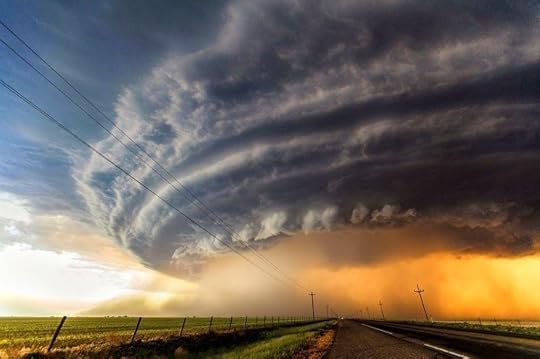 Last week two of my articles about Climate Fiction were posted on two very different e-magazines, one on Publishing Perspectives, a major stop for writers and everyone in the publishing industry, and one on Impakter, a new, fast rising culture-and-life magazine aimed at Millennials.
Last week two of my articles about Climate Fiction were posted on two very different e-magazines, one on Publishing Perspectives, a major stop for writers and everyone in the publishing industry, and one on Impakter, a new, fast rising culture-and-life magazine aimed at Millennials.The article on Publishing Perspective, "Why Climate Fiction Has Gone Viral", can be seen here and the one on Impakter, "Climate Fiction, Why it Matters" is here.
Take a look at the comments.
Notice something surprising? Yes, both articles gave rise to a large number of comments, but this is especially remarkable on Publishing Perspectives, a magazine where comments tend to be rare, maximum one or two per article and often none.
I am amazed at what happened. You talk about a new literary genre, and people get hot under the collar and hurl insults, including strong words like "you're a moron!"
What happened?
What's wrong with Climate Fiction, why is it so controversial? After all, it's fiction and it simply takes global warming as a feature in the novel's setting. A lot of fiction, particularly in the science fiction and fantasy genre, are set on much more astounding premises than simply global warming or the Sixth Extinction.
Why this should disturb anyone, including the climate change deniers, is a bit of a mystery.
Indeed, some climate fiction was famously written by a major climate change denier, Michael Crichton, who called climate activists "eco-terrorists" in his techno-thriller State of Fear. Here he is at Harvard, looking benign:
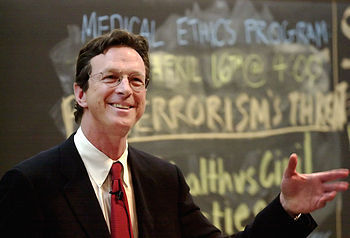 Michael Crichton speaking at Harvard (Photo credit: wikipedia)
Michael Crichton speaking at Harvard (Photo credit: wikipedia)So why the hullaballoo?
The first thing to note is that the most rabid comments come from American climate deniers - practically none coming from Europeans where climate change is a generally accepted fact of life, something we must all face.
It is really difficult to understand why America that has spawned off so many remarkable scientific breakthroughs and technical innovations should also harbor so many people determined to deny scientific evidence. Of course, America is not only home to Silicon Valley innovators and entrepreneurs, it is also home to people who cling to the past and reject current reality, like the Amish or the deniers of Darwinian evolution who want schools to teach that God created Earth four thousand years ago.
Also, looking more closely at the comments on Publishing Perspectives (I have to say this was not the case on Impakter), one notices that a great majority, over 20 comments, came from people determined to pan climate change as a Democrat partisan hoax. The United Nations also took it in the teeth - these people seem to forget that the UN Climate Change Panel is constituted by over 2,000 scientists from all over the world, including Americans who are highly respected in their own scientific community. The Panel is too large and too technical to be the prey of political games - not even American politicians can budge them.
Of course, I didn't respond to any of those comments. The article was about literature, NOT politics. Anyone commenting about climate fiction deserves an answer but a political discussion is out of bounds - over there as it is here, on my blog.
And that brings me to my last point. Why is anyone writing climate fiction the object of such violent attacks? Methinks the lady protests too much. Do climate deniers fear that they are actually on the losing end of the argument?
Only time will tell, but time is running out...
 Giorgione - The Tempest - one of my favorite painters...I feel like that bird on the roof...
Giorgione - The Tempest - one of my favorite painters...I feel like that bird on the roof...








Published on June 23, 2014 00:27
June 16, 2014
How to Use Instagram, the New Visual Twitter
Instagram, born yesterday - October 2010 - , is already a giant, over 200 million users busily sharing pictures in that weird square format typical of antiquated Polaroid photos.
When Facebook bought it in April 2012, paying one billion dollars in stock and cash, it knew what it was doing! In 2013, Instagram grew at a fast-clip 23% while Facebook crawled at 3%.
Twitter has only recently woken up to the need of sharing pictures and video clips - hence its purchase of Vine - but it looks like it might have woken up too late...
And sharing pictures on Twitter is not anywhere as easy as it is on Instagram.The user experience is very different: with Instagram, the picture leads you in, not the tweet.
Indeed, Instagram looks like it's on its way to dislodge Twitter - essentially because it responds so much better to the visual needs of the younger generation, Millennials and under.
But even a Baby Boomer like myself is beginning to catch on, take a look at my Instagram account (upper right corner) and my "likes" (press that heart!), like on this photo:

We've all heard that the future of marketing is "visual". Hence, PINTEREST and Instagram have risen to the fore in marketers' strategies (see articles below).
As far as I can tell, few writers seemed to have caught on - though I suspect the younger ones among us already have. Here's an example of how one writer uses it:

A screen shot of her book on Amazon, a short description to say that this book has achieved best seller status, a link to buy it et voilà!
Sounds good and easy-to-do (if a little pedestrian)?
Yes, it is. All you need is a smartphone (no, you can't do it from your computer) and you need to take pictures with it. Actually, it's fun, you can play with the Instagram-provided filters and come up with cool-looking pictures in a matter of seconds.
Then, throw in the picture description and appropriate hashtags, just like on Twitter, and you're done. Since June 2013, there's even a video-sharing feature (up to 5 seconds clips) - presumably a move to counteract the fast rise of Vine.
But...but, yes, there's always a "but". If you're going to sell your book outright, you won't get far.
Just look at that screen shot of the book above, it only got 9 likes (including mine). On the other hand, if you build up a reputation for good, interesting pictures that don't aim to sell anything in particular, you get loads of "likes", like this one (I just picked one at random):

Yes, that got over 1,660 "likes". And some people are so successful on Instagram that they get multiples of that for some of their images...
Some Instagram users also do eventually sell what they make, for example pieces of jewelry. Selling books? Maybe, if anyone of you has managed that, please share your experience with us!
Just one last point: hashtags.
They're like on Twitter and since you're not limited with the number of characters, you can just add them on and on, to get to a wider audience and obtain more "likes". Hashtags are also fun, anything playful goes: #selfie, #pretty, #traveljunkie etc. How to behave like a teenager is beautifully explained in this Business Insider article here
Though, as pointed out in that article, it won't win you followers if you start playing "I-follow-you/you-follow-me" then "I-unfollow-you" games just to gain followers and show how popular you are. That's the teenage approach: a lot of followers make you feel important with your friends. But followers gained that way are a mirage...
Also, remember Instagram is NOT integrated with Twitter: they decoupled the day Facebook bought them, now they are rivals and you won't be able to tweet links to your Instagram photos. Ah, the joys of the Net!
Still, just like on Facebook, you can make comments:

And that's a good way to connect - even if a little superficial. But don't look for deep meaning, after all, these are just pictures.
You know what's Instagram's secret for success?
It's just plain....fun!
Related articles Social media trends for 2014(hiscox.co.uk)
Social media trends for 2014(hiscox.co.uk)
 Why Marketers Love Instagram And Pinterest(fastcompany.com)
Why Marketers Love Instagram And Pinterest(fastcompany.com)
 Pinterest vs. Instagram: Pros and Cons for Brands(cyberalert.com)
Pinterest vs. Instagram: Pros and Cons for Brands(cyberalert.com)
 Stop Tweeting Instagram Links(buzzfeed.com)
Stop Tweeting Instagram Links(buzzfeed.com)
 4 Tips To Instagram Your Business(marketingland.com)
4 Tips To Instagram Your Business(marketingland.com)









When Facebook bought it in April 2012, paying one billion dollars in stock and cash, it knew what it was doing! In 2013, Instagram grew at a fast-clip 23% while Facebook crawled at 3%.
Twitter has only recently woken up to the need of sharing pictures and video clips - hence its purchase of Vine - but it looks like it might have woken up too late...
And sharing pictures on Twitter is not anywhere as easy as it is on Instagram.The user experience is very different: with Instagram, the picture leads you in, not the tweet.
Indeed, Instagram looks like it's on its way to dislodge Twitter - essentially because it responds so much better to the visual needs of the younger generation, Millennials and under.
But even a Baby Boomer like myself is beginning to catch on, take a look at my Instagram account (upper right corner) and my "likes" (press that heart!), like on this photo:

We've all heard that the future of marketing is "visual". Hence, PINTEREST and Instagram have risen to the fore in marketers' strategies (see articles below).
As far as I can tell, few writers seemed to have caught on - though I suspect the younger ones among us already have. Here's an example of how one writer uses it:

A screen shot of her book on Amazon, a short description to say that this book has achieved best seller status, a link to buy it et voilà!
Sounds good and easy-to-do (if a little pedestrian)?
Yes, it is. All you need is a smartphone (no, you can't do it from your computer) and you need to take pictures with it. Actually, it's fun, you can play with the Instagram-provided filters and come up with cool-looking pictures in a matter of seconds.
Then, throw in the picture description and appropriate hashtags, just like on Twitter, and you're done. Since June 2013, there's even a video-sharing feature (up to 5 seconds clips) - presumably a move to counteract the fast rise of Vine.
But...but, yes, there's always a "but". If you're going to sell your book outright, you won't get far.
Just look at that screen shot of the book above, it only got 9 likes (including mine). On the other hand, if you build up a reputation for good, interesting pictures that don't aim to sell anything in particular, you get loads of "likes", like this one (I just picked one at random):

Yes, that got over 1,660 "likes". And some people are so successful on Instagram that they get multiples of that for some of their images...
Some Instagram users also do eventually sell what they make, for example pieces of jewelry. Selling books? Maybe, if anyone of you has managed that, please share your experience with us!
Just one last point: hashtags.
They're like on Twitter and since you're not limited with the number of characters, you can just add them on and on, to get to a wider audience and obtain more "likes". Hashtags are also fun, anything playful goes: #selfie, #pretty, #traveljunkie etc. How to behave like a teenager is beautifully explained in this Business Insider article here
Though, as pointed out in that article, it won't win you followers if you start playing "I-follow-you/you-follow-me" then "I-unfollow-you" games just to gain followers and show how popular you are. That's the teenage approach: a lot of followers make you feel important with your friends. But followers gained that way are a mirage...
Also, remember Instagram is NOT integrated with Twitter: they decoupled the day Facebook bought them, now they are rivals and you won't be able to tweet links to your Instagram photos. Ah, the joys of the Net!
Still, just like on Facebook, you can make comments:

And that's a good way to connect - even if a little superficial. But don't look for deep meaning, after all, these are just pictures.
You know what's Instagram's secret for success?
It's just plain....fun!
Related articles
 Social media trends for 2014(hiscox.co.uk)
Social media trends for 2014(hiscox.co.uk)
 Why Marketers Love Instagram And Pinterest(fastcompany.com)
Why Marketers Love Instagram And Pinterest(fastcompany.com)
 Pinterest vs. Instagram: Pros and Cons for Brands(cyberalert.com)
Pinterest vs. Instagram: Pros and Cons for Brands(cyberalert.com)
 Stop Tweeting Instagram Links(buzzfeed.com)
Stop Tweeting Instagram Links(buzzfeed.com)
 4 Tips To Instagram Your Business(marketingland.com)
4 Tips To Instagram Your Business(marketingland.com)








Published on June 16, 2014 07:40
June 12, 2014
What’s wrong with the UN Security Council
Here's another article about the UN I wrote for the magazine Impakter under my real name: Claude Forthomme (published on 9 June, 2014) - after all, after 25 years of service in the United Nations, I believe I know a thing or two about it!
Enjoy and let me know what you think!
 What’s wrong with the UN Security CouncilTo an idle observer dropping in from Outer Space, the UN Security Council is the strongest organ of the United Nations.
What’s wrong with the UN Security CouncilTo an idle observer dropping in from Outer Space, the UN Security Council is the strongest organ of the United Nations.Tasked with maintaining peace among nations, it has been given weapons of war. When it passes a resolution, it can send troops, the blue-helmeted UN peacekeepers or “blue berets”, and force peace on belligerents. Blue berets belong to member nations’ armies, but taken together, they constitute a hefty, permanent UN force.
This level of intervention dates to the collapse of the Soviet Union (1988): the number of resolutions doubled, the peace-keeping budget increased by a factor of ten. So far, there have been eight major missions, with only two notable failures, Somalia and Bosnia. A respectable record nonetheless. The biggest failure however was caused by lack of intervention. This happened in 1994, when one of History’s worst genocide was perpetrated in Rwanda.At this point in time, over 110,000 military personnel are permanently deployed around the world in “hot spots”, currently in 15 “missions”.
 UN Security Council Meets on Rwanda 08 June 1994
UN Security Council Meets on Rwanda 08 June 1994 The Security Council can do more than send troops....
TO READ THE REST, CLICK HERE.









Published on June 12, 2014 07:40
June 11, 2014
Can an Artist Have a Second Life after Death?
When most of us die, we remain as a memory for our family and closest friends. For artists, it can be different...With a bit of luck and help from those who have loved us.
Raymond Spillenger, a 1950s-60s artist belonging to the New York school of Abstract Expressionism, who died a few months ago (in November 2013 at the age of 89) has suddenly come back on the scene - propelled there by the New York Times in a fascinating article: see here.
But all that didn't happen by pure chance. Spillenger's two sons discovered his paintings stacked up in his East Village apartment; here is son Paul among the paintings:

As you can see, Spillenger's early work fitted in the mold of Abstract Expressionism - no surprise there, he worked in New York in the 1950s and most of his friends were abstract expressionists, including De Kooning; the latter however clearly overshadowed him and went on to become recognized as a major artist in the movement, leaving Spillenger (and who knows how many others) in the dust.
There was even a moment in Spillenger's life that he stopped painting - no doubt, he was deeply disillusioned. That's easy to understand, all artists go through these dark periods...
He managed to climb out of the depression and late in his life,in the 1990s, he started painting again. And the stuff he produced this time is eye-catching and much more personal. For example, this semi-abstract nude:

I think it's breathtakingly beautiful and full of movement...
Your views?
My hope is that this is an artist headed for revival - it would be surely well-deserved.
Related articles Abstract Painter's Afterlife, Reborn(nytimes.com)
Abstract Painter's Afterlife, Reborn(nytimes.com)









Raymond Spillenger, a 1950s-60s artist belonging to the New York school of Abstract Expressionism, who died a few months ago (in November 2013 at the age of 89) has suddenly come back on the scene - propelled there by the New York Times in a fascinating article: see here.
But all that didn't happen by pure chance. Spillenger's two sons discovered his paintings stacked up in his East Village apartment; here is son Paul among the paintings:

As you can see, Spillenger's early work fitted in the mold of Abstract Expressionism - no surprise there, he worked in New York in the 1950s and most of his friends were abstract expressionists, including De Kooning; the latter however clearly overshadowed him and went on to become recognized as a major artist in the movement, leaving Spillenger (and who knows how many others) in the dust.
There was even a moment in Spillenger's life that he stopped painting - no doubt, he was deeply disillusioned. That's easy to understand, all artists go through these dark periods...
He managed to climb out of the depression and late in his life,in the 1990s, he started painting again. And the stuff he produced this time is eye-catching and much more personal. For example, this semi-abstract nude:

I think it's breathtakingly beautiful and full of movement...
Your views?
My hope is that this is an artist headed for revival - it would be surely well-deserved.
Related articles
 Abstract Painter's Afterlife, Reborn(nytimes.com)
Abstract Painter's Afterlife, Reborn(nytimes.com)








Published on June 11, 2014 02:58
June 8, 2014
A Novel Rejected by Big Publishers Wins a Major Literary Prize
There's hope for recognition for all of us poor writers... The lesson is: never give up, keep trying!
That's what Irish author Eimar McBride did, she never gave up and this week-end the news came in: she just won the Baileys Women's Prize for Fiction for her debut novel, "A Girl is a Half-Formed Thing".
That in itself would perhaps not be so remarkable, after all, it's a damn good title and universally considered to be "well-written, the work of a genius", if it weren't for the fact that Ms. McBride has spent nearly a decade trying to get published!
You read that right: almost 10 years trying...Yes, that's true determination for you! She was finally published in the UK by a small independent press and her book will come to the US in the fall, published by Coffee House Press. If you go on the website of her publisher, you discover it's an australian publisher and while her book is among the top ten, it is ranked...number five (but they quickly featured the book cover on their site - I love it!):

The book is available on Amazon.uk here, where it has garnered 27 customer reviews and is currently ranked at #50 in "contemporary fiction". And it's already in the US in ebook format, on Amazon.com here where it has only 6 customer reviews so far and stands at #10,837, as I write. But that is certain to change soon!
And to think she has beaten in the short list big name novelists like Donna Tartt, Chimamanda Ngozi Adichie and Jhumpa Lahiri...
Really a good reason to smile:
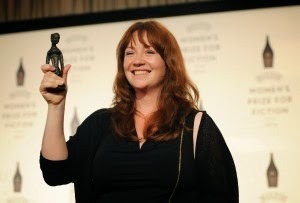
She wrote the book in 6 months when she was 27 and took all this time - she is now 36 - to get it published. Why? Because, as she told the BBC, publishers liked her writing but saw unsurmountable marketing difficulties, her book didn't fit into a "niche".
I haven't read it, but it's reportedly written in an unusual stream-of-consciousness style that takes you into the character's head and the subject is certainly harrowing: all about a young girl growing up in Ireland in the 1980s, going through a difficult relationship with her brother affected by a brain tumor in childhood. Add sexual abuse to the mix and you have a winner! Helen Fraser, chair of judges, said of McBride’s startling novel: “An amazing and ambitious first novel that impressed the judges with its inventiveness and energy. This is an extraordinary new voice – this novel will move and astonish the reader.”
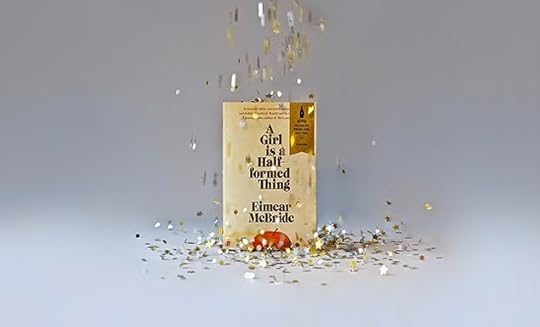
And plenty of money is showered on the winner: a £30,000 prize plus the bronze statuette - in this case, well-deserved.
Fortunately not at all like the ending in Edward St Aubyn's brilliant new novel, Lost for Words (no spoilers, I won't tell you how it ends but it's very funny). That book bashes literary prizes in a hilarious way and it is clearly a "roman à clefs", with references to real people, no doubt celebrities that I cannot fathom not being into the London literary scene. But of one thing I'm certain, "Lost for Words" makes no references to the Baileys - it is more likely a bashing of the Man Booker Prize...
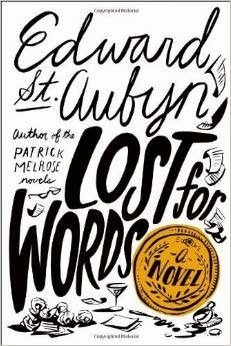
I love that cover too...
So, I'm bringing you good news. While it's true that literary prizes have problems as St Aubyn so brilliantly and entertainingly points out, they can also make the difference in a writer's life...Congrats to Eimar!
Related articles Debut Irish novelist wins Baileys Women's Prize for Fiction(washingtonpost.com)
Debut Irish novelist wins Baileys Women's Prize for Fiction(washingtonpost.com)
 Eimear McBride wins Baileys prize(bbc.co.uk)
Eimear McBride wins Baileys prize(bbc.co.uk)










That's what Irish author Eimar McBride did, she never gave up and this week-end the news came in: she just won the Baileys Women's Prize for Fiction for her debut novel, "A Girl is a Half-Formed Thing".
That in itself would perhaps not be so remarkable, after all, it's a damn good title and universally considered to be "well-written, the work of a genius", if it weren't for the fact that Ms. McBride has spent nearly a decade trying to get published!
You read that right: almost 10 years trying...Yes, that's true determination for you! She was finally published in the UK by a small independent press and her book will come to the US in the fall, published by Coffee House Press. If you go on the website of her publisher, you discover it's an australian publisher and while her book is among the top ten, it is ranked...number five (but they quickly featured the book cover on their site - I love it!):

The book is available on Amazon.uk here, where it has garnered 27 customer reviews and is currently ranked at #50 in "contemporary fiction". And it's already in the US in ebook format, on Amazon.com here where it has only 6 customer reviews so far and stands at #10,837, as I write. But that is certain to change soon!
And to think she has beaten in the short list big name novelists like Donna Tartt, Chimamanda Ngozi Adichie and Jhumpa Lahiri...
Really a good reason to smile:

She wrote the book in 6 months when she was 27 and took all this time - she is now 36 - to get it published. Why? Because, as she told the BBC, publishers liked her writing but saw unsurmountable marketing difficulties, her book didn't fit into a "niche".
I haven't read it, but it's reportedly written in an unusual stream-of-consciousness style that takes you into the character's head and the subject is certainly harrowing: all about a young girl growing up in Ireland in the 1980s, going through a difficult relationship with her brother affected by a brain tumor in childhood. Add sexual abuse to the mix and you have a winner! Helen Fraser, chair of judges, said of McBride’s startling novel: “An amazing and ambitious first novel that impressed the judges with its inventiveness and energy. This is an extraordinary new voice – this novel will move and astonish the reader.”

And plenty of money is showered on the winner: a £30,000 prize plus the bronze statuette - in this case, well-deserved.
Fortunately not at all like the ending in Edward St Aubyn's brilliant new novel, Lost for Words (no spoilers, I won't tell you how it ends but it's very funny). That book bashes literary prizes in a hilarious way and it is clearly a "roman à clefs", with references to real people, no doubt celebrities that I cannot fathom not being into the London literary scene. But of one thing I'm certain, "Lost for Words" makes no references to the Baileys - it is more likely a bashing of the Man Booker Prize...

I love that cover too...
So, I'm bringing you good news. While it's true that literary prizes have problems as St Aubyn so brilliantly and entertainingly points out, they can also make the difference in a writer's life...Congrats to Eimar!
Related articles
 Debut Irish novelist wins Baileys Women's Prize for Fiction(washingtonpost.com)
Debut Irish novelist wins Baileys Women's Prize for Fiction(washingtonpost.com)
 Eimear McBride wins Baileys prize(bbc.co.uk)
Eimear McBride wins Baileys prize(bbc.co.uk)










Published on June 08, 2014 09:20

